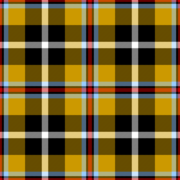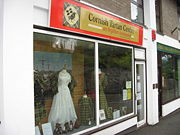
Cornish tartans
Encyclopedia

Kilt
The kilt is a knee-length garment with pleats at the rear, originating in the traditional dress of men and boys in the Scottish Highlands of the 16th century. Since the 19th century it has become associated with the wider culture of Scotland in general, or with Celtic heritage even more broadly...
was plain black, and other patterns followed. It is documented that a garment known as a bracca (a reddish checkered tunic
Tunic
A tunic is any of several types of clothing for the body, of various lengths reaching from the shoulders to somewhere between the hips and the ankles...
) was worn by Celtic races that inhabited the British Isles
British Isles
The British Isles are a group of islands off the northwest coast of continental Europe that include the islands of Great Britain and Ireland and over six thousand smaller isles. There are two sovereign states located on the islands: the United Kingdom of Great Britain and Northern Ireland and...
, the term indicating its appearance. The Welsh word brech means 'checkered' (compare the cognate
Cognate
In linguistics, cognates are words that have a common etymological origin. This learned term derives from the Latin cognatus . Cognates within the same language are called doublets. Strictly speaking, loanwords from another language are usually not meant by the term, e.g...
Scottish Gaelic breac, 'variegated, freckled'), and the word bracca is derived from the Welsh or Cornish word brythen which in English translates as 'striped' or 'checkered'."
Cornish historian L.C.R. Duncombe-Jewell was the first to prove that plain kilts were in use in Cornwall
Cornwall
Cornwall is a unitary authority and ceremonial county of England, within the United Kingdom. It is bordered to the north and west by the Celtic Sea, to the south by the English Channel, and to the east by the county of Devon, over the River Tamar. Cornwall has a population of , and covers an area of...
. He discovered that carvings of minstels dressed in kilts and playing bagpipes on bench ends at Altarnun
Altarnun
Altarnun is a village and civil parish in Cornwall, United Kingdom. It is located on the north-eastern edge of Bodmin Moor at .The parish of Altarnun includes the village of Fivelanes and the hamlets of Bolventor, Treween and Trewint, and had a population of 976 according to the 2001 census...
church dated from circa 1510. some however contend that these images are more likely to be medieval belted tunics that were common throughout Europe. The earliest historical reference to the Cornish kilt is from 1903 when the Cornish delegate to the Celtic Congress, convening at Caernarvon, L. Duncombe-Jewell, appeared in a in a woad blue kilt. John T. Koch in his work Celtic Culture: a Historical Encyclopedia mentions a black kilt worn by the Duke of Cornwall's Light Infantry
Duke of Cornwall's Light Infantry
The Duke of Cornwall's Light Infantry was an infantry regiment of the British Army from 1881 to 1959. Its lineage is continued today by The Rifles....
in combat - however no historical reference is provided to support this claim.
National tartans

Robert Morton Nance
Robert Morton Nance was a leading authority on the Cornish language, nautical archaeologist, and joint founder of the Old Cornwall Society....
. Each colour of tartan has a special significance or meaning. The White Cross on a black background is from the banner of Saint Piran
Saint Piran
Saint Piran or Perran is an early 6th century Cornish abbot and saint, supposedly of Irish origin....
, the Patron Saint of tinners, which is also used as the flag of Cornwall
Saint Piran's Flag
Saint Piran's Flag is the flag of Cornwall, in the United Kingdom. The earliest known description of the flag as the Standard of Cornwall was written in 1838. It is used by Cornish people as a symbol of identity. It is a white cross on a black background....
; Black and gold were the colours of the ancient Cornish kings
Kings of Dumnonia
The kings of Dumnonia ruled the large Brythonic kingdom of Dumnonia in the south-west of Great Britain during the Sub-Roman and early medieval periods....
; red for legs and beak of the national bird, the chough
Chough
The Red-billed Chough or Chough , Pyrrhocorax pyrrhocorax, is a bird in the crow family; it is one of only two species in the genus Pyrrhocorax...
, and blue for the blue of the sea surrounding Cornwall. A prototype of the Cornish national tartan was first worn by Morton-Nance in the 1963 Celtic Congress
Celtic Congress
The International Celtic Congress is a cultural organisation that seeks to promote the Celtic languages of the nations of Ireland, Scotland, Wales, Brittany, Cornwall and the Isle of Man. It was formed out of previously existing bodies that had sought to advance the same goals such as the Celtic...
held at Carbis Bay
Carbis Bay
Carbis Bay is a village and seaside resort in Cornwall, United Kingdom. It lies one mile SE of St Ives on the west side of St Ives Bay on the Atlantic coast....
attached to a Clan Douglas
Clan Douglas
Clan Douglas is an ancient Scottish kindred from the Scottish Lowlands taking its name from Douglas, South Lanarkshire, and thence spreading through the Scottish Borderland, Angus, Lothian and beyond. The clan does not currently have a chief, therefore it is considered an armigerous clan.The...
kilt that he was wearing for the occasion. The Cornish Hunting Tartan was registered in the 1980s.
The following Cornish tartans have been registered or have been previously registered. Some of theses are Cornish family tartans which are worn at family get togethers and weddings..
- Cornish National Tartan (registry #1567)
- Cornish Hunting Tartan (registry #1568)
- Saint PiranSaint PiranSaint Piran or Perran is an early 6th century Cornish abbot and saint, supposedly of Irish origin....
Cornish Flag Tartan (registry #1618) - Saint PiranSaint PiranSaint Piran or Perran is an early 6th century Cornish abbot and saint, supposedly of Irish origin....
Cornish Dress Tartan (registry #1685) - Cornish National Day Tartan (registry #1262)
- Christopher family Tartan (registry #2809)
- Rosevear Tartan (registry #2541)
- Curnow of Kernow Tartan (registry #4084).
- Pengelly, The Cornish (STWR ref: 3145)
Literature
Bedheugh benytha kernewek!- (March of the Cornish tartan)*
Hail! Kernow's heritage, tartan.
Hail! Garb of old Gaul, the kilt.
Our forebears gloried in tartan -
Baptized in blood Roman spilt.
E.E. Morton-Nance = Herald Bard Gwas Gweth.
External links
- Cornish National Tartan
- http://www.alanrichards.org/cornishtartan.htm
- Cornish tartans
- Cornish Kilts
- Cornish Tartan Information and Images

